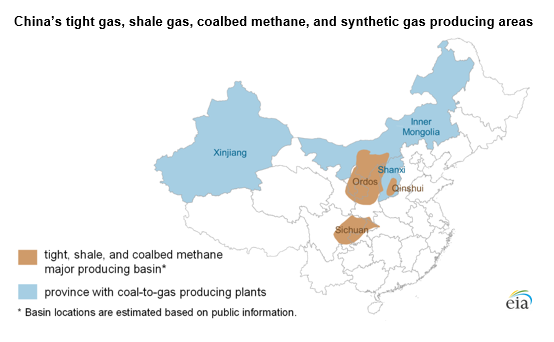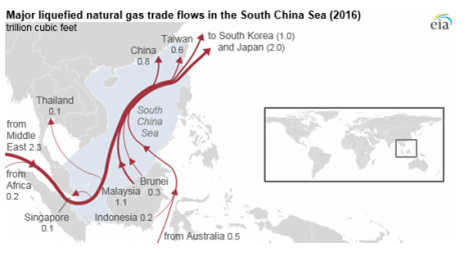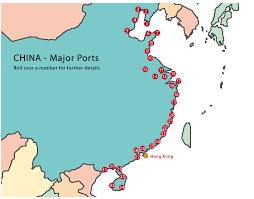By Amit Sinha
New Delhi, Dec 2 (UNI) China’s natural gas production was around 120 bcm in 2020 and could reach 175-180 bcm in 2030. IEA (International Energy Agency) (2015) indicates that China’s natural gas production prospects will depend heavily on its unconventional gas development, which faces various barriers from environmental and social hazards and geological challenges.
China began to import LNG-based natural gas in 2006 and pipeline gas since 2010. According to China’s National Bureau of Statistics, China imported 33.6 bcm and 26.8 bcm of natural gas by pipeline and LNG in 2015, respectively. China’s dependence on foreign natural gas was 31.3% in 2015, while imports were only 1.8% in 2006. By 2030 it is likely to be well over 60%.
Natural Gas is transported in two ways. The first way is to pump through pipelines from the production site to the consumption site. This is feasible over long stretches and more economical. The second way is to compress it into LNG, transport it by sea (or land) to a receiving station, regasification, and then pump through pipelines. This is more expensive. For instance, northern Europe receives pipeline Natural Gasfrom Russia and also Natural Gasfrom other sources. The cost to customers via LNG route is often 60-80% higher. Pipelines are preferred and most gas using countries build extensive pipelines to take Natural Gasfrom either the production sites or the LNG terminals to the consumption sites.
China’s gas pipeline network

As is evident, China’s consumption/ demand centers are in the East. Its domestic production centers are in the Central region and the Xinjiang province in the west. We will come back to this a little later.
CNPC is the largest natural gas producer and supplier in China, providing more than 61.9% of China’s gas supply and operating 75.2% of China’s gas pipeline. By the end of 2019, they operated pipelines in China totaled 90,352 kilometers, including 20,779 kilometers for crude oil, 55,810 kilometers for natural gas, and 13,762 kilometers for refined products. That’s the scale at which the infrastructure for gas supplies has been built.
External linkages
• China-Myanamar pipeline - capacity 12 Bcm, operating since 2013, overseas length 793 km
• Central Asia pipeline A/B line - capacity 30 Bcm, operating since 2010, overseas length 1,830 km (A/B/C together)
• Central Asia pipeline C line - capacity 25 Bcm, operating since 2014.
• Central Asia pipeline D line - capacity 30 Bcm, in planning/ construction, overseas length 840 km
• Power of Siberia - capacity 38 Bcm, operating since 2019, overseas length 4,000 km
• Altai (China-Russia west line) - capacity 30 Bcm, in planning/ construction, overseas length 2,600 km
The size and spread of these projects gives one a clear idea of where china is looking to in order to secure its Natural Gassupplies.

The Xinjiang province is extremely important for China. It’s a major production center for domestic gas and is the conduit for pipelines stretching to gas rich Central Asia (Kazakhstan, Turkmenistan, and Uzbekistan). Moreover, there is possibility of stretching this further to Iran which has the second largest gas reserves in the world (2nd only to Russia). The importance of Xinjiang to China’s very existence explains its approach to the Uyghur majority region. China can ill-afford any dislocation/ disruption here. It has preemptively come down hard on any potential trouble, defying international opinion. There’s a second story here. China has built roadways from Xinjiang to Gawadhar port in Pakistan. This port is being developed as a large oil and gas terminal which will receive supplies from the Persian Gulf countries. If things go according to plan, China would like to build a pipeline from Gawadhar to Xinjiang and further deepen its reach towards production centers.
LNG imports
A large part of China’s imports used to be via LNG terminals on the East coast. All the major ports of China are located here and so are the demand centers. The strategic shift happened about 10 years ago as China felt the need to diversify its supply lines. The South China sea has several choke points and leaves China vulnerable to external pressures. The tensions in this region are a subject matter for another day and we will not go into too much details, but we shall touch upon the obvious ones.

The South China Sea is full of oil and gas, but has competing claims by several countries that surround it. In addition, all shipping routes from the Persian Gulf and Europe (to and fro) go via the narrow straits of Malacca. The United States has major presence here with bases in The Philippines, Japan, Korea, and Taiwan.
These are large bases.

All Chinese ports and therefore their access to global trade are located here. Given the long term vulnerability, and the inherent cost advantages of piped gas, China has naturally looked westwards and northwards (Central Asia and Russia) to address its long term energy security needs. It has worked diligently towards this. The Myanmar pipeline is also a strategically sound investment. It lies closer to India, well away from Malacca. This makes sure that a part of the LNG supplies can be routed through here instead of the South China Sea. Moreover, Bangladesh is a country with large Natural Gas reserves and can be connected to the Myanmar pipeline easily. It’s a matter of time before we start seeing Chinese investments in Bangladesh. Additionally, China has built and secured a port in Hambantota (Sri Lanka) which further adds to its strategic depth.
(Disclaimer: The writer is an Adjunct Faculty at Jindal Global Business School. Views, thoughts, and opinions expressed in the write-up belong solely to the author.)
UNI AMIT JAL JW1744